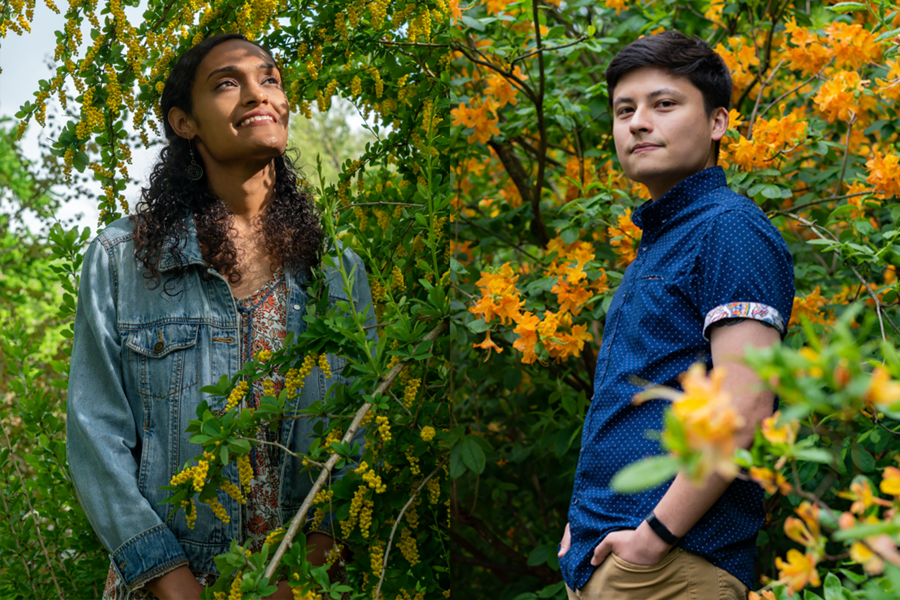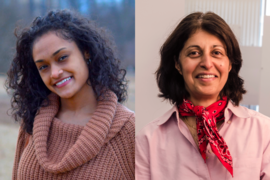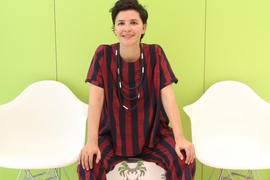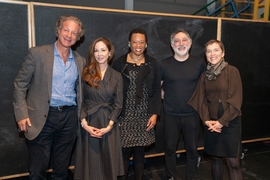Christian Loyo of the Grossman lab and Sheena Vasquez of the Drennan lab, both graduate students in the Department of Biology, were recently selected to participate in The Poetry of Science. The project, founded by Joshua Sariñana PhD ’11, aims to advance racial justice at the intersection of science and art by bringing together Cambridge, Massachusetts-affiliated poets and scientists of color to create poems about scientific research. These poems will be on public display, along with the scientists’ portraits, at the Massachusetts General Hospital main lobby from Nov. 13 through Nov. 30 and the Rotch Library at MIT during Independent Activities Period (IAP) in January 2022.
For Loyo and Vasquez, The Poetry of Science was the ideal opportunity to create something of impact by combining their personal passions for poetry, science communication, and racial justice. They worked with two poets (Danielle Legros Georges and Luisa Fernanda Apolaya Torres, respectively) to create poems about their research. Loyo and Vasquez sat down to discuss the project.
Q: Both of you are accomplished scientists, but you also spend time working within your communities on various outreach programs. How have these experiences influenced the way you approach your scientific research or your roles as scientists?
Vasquez: I’ve conducted outreach from K-12 to the undergraduate level during my time here at MIT. My most recent outreach is targeted to local community colleges around MIT, including Bunker Hill Community College and Roxbury Community College. Outreach experiences really make me take a step back and think about how to make my science more accessible to the general public. Overall, experiences like these allow me to enhance my mentoring skills. Working with students from different backgrounds shows me how fortunate I am to conduct research at one of the top institutions in the world. If I can make it at an institute like MIT, I feel like anyone else can.
Loyo: For me, it was not easy to get into science. It took a lot of people who became my mentors to teach me what I now know about being a scientist and navigating academia. As an undergrad, I was looking for a research lab and I emailed probably 50 professors; none of them had room. I was about to give up when I finally found one professor who wanted to meet and take a chance on me. This meant a lot to me and is actually in Luisa's poem. I ended up having a great experience and exploring research questions at a pretty high level for an undergraduate. This opportunity made me realize it’s really important to pay it forward. There are a lot of people who are having a tougher time than I ever did getting into science. Helping them ensures that the future of science is more inclusive.
Q: Science and art are often seen as two distinct disciplines, but The Poetry of Science project is all about bridging that gap. How do you think combining science and the arts can further the goal of advancing racial justice?
Loyo: I think science is about understanding the universe that we live in, and art is about understanding what it means to be human. Because we are human, we all have biases. One of those biases can be racial bias. If you look at who has historically been doing science, it’s mostly white men. That’s not because those people were the best at science; that’s because everyone else was not traditionally allowed to do science. Art gives us an opportunity to share our experiences as people from these historically excluded groups, and to highlight how we became scientists — even if, growing up, we didn’t often see scientists who looked like us.
Vasquez: The Poetry of Science exhibition also offers a chance to create new and positive representations of people of color. More examples of people of color in science helps us break down stereotypes and learn more about the individuals themselves. It allows for more stories to be told in different ways, which creates room for different perspectives. For example — and Danielle included this in her poem — something I really wish people would know is that I’m human, and, just like all scientists, I make mistakes. I am still learning and growing.
Q: What was it like to communicate your research through poetry, and how do you think the arts contribute to scientific literacy?
Vasquez: It was interesting to see what Danielle latched onto when I was explaining my research to her. For example, there’s part of the poem where she writes about how the proteins spiral, and she compares them to a girl’s curly hair. That was the alpha helix I was showing her, and it does spiral like a girl’s hair — like both of our hair. It was neat to see how she made connections between my science and general life.
The arts bring science to life, which helps improve scientific literacy. That’s important because it puts us all on the same page about what’s true and what’s not true. If we didn’t have certain scientific understandings about viruses, for example, we would not have made it this far in combating the pandemic.
Loyo: When you write a poem about science, it becomes much less about the nitty-gritty details, and instead captures the love behind the research. There’s this wonder and awe that we have for the natural world, and when we can discover something about the natural world that we didn’t know before, that feels so good. People really connect to your work when they can feel that same sort of excitement and emotion.
People also take pride in art. For example, I’m of Mexican descent, and I am a big fan of Frida Kahlo and Diego Rivera, who are Mexican painters. Using art can connect people to science even if they don’t really know what the science is about. If they can see that the person doing the experiments, for example, also grew up where they grew up, that can really be beneficial.









